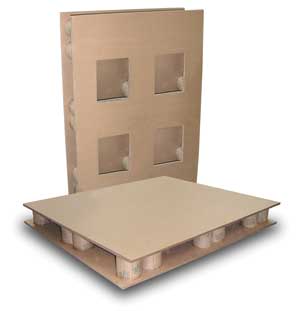
Getting the bugs out
By Andrew Joseph, Features Editor
AutomationA global regulation on transporting wood pallets and other wood packaging may have implications for Canada-U.S. trade
A pallet may be just a humble pallet to some, but in the context of crossborder trade between Canada and the U.S., not keeping up with legislation governing the proper use of wood, plastic, corrugated and enhanced-wood pallet can be a serious oversight for any exporting company—especially in light of the soon-to-be-enforced North American regulation introducing strict new standards for how freight is packaged and transported.
Tracing back to the 2002 implementation of the ISPM (International Standards for Phytosanitary Measures) 15 by the Interim Commission on Phytosanitary Measures of the International Plant Protection Convention, this groundbreaking document—titled Guidelines for Regulating Wood Packaging Material in International Trade—provided formal international acknowledgments of the inherent pest risks associated with the international movement of untreated wood packaging materials.
Although the voluntary standard did not obligate participatory countries to establish strict regulatory controls for immediate standard compliance, it did provide an important international mechanism for countries to establish such internationally harmonized controls.
In North America, the ISPM 15 was slight revised two years ago as ISPM 15 (2009), which applies to all tree species used commercially as raw wood packaging material.
According to the federal Canadian Food Inspection Agency (CFIA) the term WPM (wood packaging material)—including dunnage, crating, wood boxes, pallets, wooden drums and skid—is any piece of non-manufactured wood used to brace, support, protect or secure a consignment or cargo, .
“Any WPMs made of 100-percent manufactured parts like plywood and veneer, reconstituted wood products like chipboard, presswood, particle board, medium- and high-density fiber board, plastics, oriented strand board, corrugated (cardboard), or products manufactured by using adhesives, heat and pressure or a combination thereof, are exempt from import requirements,” explains CFIA forestry specialist Mélanie Mecteau.
As a member of the United Nations (UN)’s International Plant Protection Convention (IPPC) committee, Canada adopted the WPM standard in 2006 as its national import policy directive for all wood packaging materials originating in Canada and the U.S., albeit agreeing not to apply requirements to wood packaging materials originating and moving between the two countries. While the exemption remains in force, both countries have agreed to begin implementation of ISPM 15 (2009) for WPM moving between Canada and the U.S. until 2013—joining another 88 countries that have adopted ISPM 15 (2009) as their import requirements for WPM including Canada and the U.S.
 Pesky Pests
Pesky Pests
“While Canada does have some insect pests that the U.S. doesn’t have and vice versa, the reason for ISPM 15 (2009) existence is not to be a thorn in the foot of sectors like the pallet manufacturing industry,” states Mecteau, “but rather to prevent the entry and spread of the exotic pests, like the Asian longhorned beetle and the emerald ash borer, to protect our valuable natural wood resources from further devastation.”.
Native to China and eastern Asia, the emerald ash borer is an invasive beetle that was first detected in North America in 2002, and is widely believed to have been introduced accidentally via imported wood packaging or crating material arriving from Asia.
Despite its relatively recent migration here, it is believed to have already killed millions of trees in Canada and the U.S., according to Mecteau, with billions more across the continent considered to be at risk of infestation and death.
Attacking a wide range of deciduous trees, the voracious Asian longhorned beetle was discovered in the U.S. in 1996, before making its way to Canada and several European countries, and is also suspected to have been transported from Asia via solid wood packaging material.
According to Mecteau, ISPM 15 (2009) recommends that all wood packaging material must be appropriately treated and marked with the official IPPC stamp containing the IPPC logo, the country code, the producer/treatment provider code, and the treatment code. In addition, a unique stamp issued by each country’s federal authority on plant protection will be given to each facility producing compliant WPM so it can be traced back to its point-of-origin.
“While Canada does not currently regulate wood packaging materials originating in the U.S., we have developed bilateral phytosanitary measures with them to protect Canada,” says Mecteau adding that by January 2013 all importers and suppliers of Canadian goods—as well as their American counterparts— must ensure that wood packaging materials used to ship their goods meet the ISPM 15 (2009) specifications to avoid border crossing delays or outright rejection at border points of entry.
Currently, there are two approved treatment methods with meet the ISPM 15 (2009) standards:
• WPM must be heated in accordance with a specific time-temperature schedule that achieves a minimum temperature of 56 Celsius for a minimum 30 continuous minutes throughout the entire profile of the wood, including its core. For example, kiln-drying, heat-enabled chemical pressure impregnation, microwave or other treatments may be considered, provided they meet the parameters.
• All WPM must be fumigated with methyl bromide per the schedule set out in ISPM 15’s Annex 1.
 Brian Isard, director of procurement and risk management with pallet pooling services provider CHEP Canada Inc. of Mississauga, Ont., says he has deep reservations about the two suggested methods
Brian Isard, director of procurement and risk management with pallet pooling services provider CHEP Canada Inc. of Mississauga, Ont., says he has deep reservations about the two suggested methods
“We have been talking with CFIA to achieve compliance by alternative means since 2008,” states Isard, explaining that CHEP the director of procurement and risk management working out of CHEP’s
CHEP manufactures its block pallets using traditional methods and 100-percent kiln-dried lumber that dries the wood out—making it inhospitable
to pests.
“CHEP operates a managed pallet pool that effectively mitigates the risk of harboring these pest species,” he points out, “but even though there is not one documented instance of a CHEP block pallet being contaminated with a pest, the government is still asking us to do it their way.
Isard says that CHEP, long with other key members of the Canadian Wood Pallet and Container Association (CWPCA)—have some serious questions about ISPM 15 (2009) and its role within the Canadian industry.
“There is some concern with the Canadian pallet industry that the regulation has the potential to be a trade impediment if the timelines to comply with ISPM 15 (2009) are accelerated,” reveals Isard. “However, our main concern is that there still remain a number of harmonization issues that need to be addressed between the two countries in the implementation of these new regulations.”
Isard claims that despite ISPM 15 having been discussed in Canada and the U.S. for a number of years—involving amendments and changes to the Plant Protection Act in Canada—manufacturers shipping product are often unaware of these pending changes.
As a result, they may not have adequate time to organize themselves fiscally for these changes—like ensuring the pallets they are using are fully ISPM 15 (2009) compliant.
Isard says it should be the responsibility of CFIA and APHIS to notify all border agencies of the new regulation and then take the time to train them to adequately deal with it.
“It has the potential to cause serious delays in crossborder shipping if not properly implemented,” he asserts.
“While we are highly supportive of the intent of the proposed rule-making to prevent the spread of invasive pest species and to protect our nation’s forests, we feel strongly that any new regulation would take into account the existence of managed pallet pooling systems,” he expands.
“For instance, CHEP operates a pallet pooling system in which it maintains ownership of its assets at all points in the supply chain, controls the sourcing of all lumber used in pallet manufacture and repair and enforces rigorous quality and pest control standards,” he states “already meeting ISPM 15 pest and disease prevention and control objectives.”
While the wood pallet industry is still looking for answers regarding the implementation of ISPM 15 (2009), pallet manufacturers utilizing alternate non-wood materials such as plastic or corrugated—such as the Canadian, Que.-based Corrupal Inc. —are looking forward to the new requirements in the hopes it will create a more even playing field.
“In my opinion, it seems as though the wood pallet industry has seen the ISPM 15 (2009) regulations, but is not fully prepared to deal with it,” opines Corrupal president Yvan Quirion, whose company first created a corrugated pallet back in 1991.
Quirion admits that the concept of a corrugated pallet may come first come across as rather strange to companies wondering pallet made of ‘cardboard’ is going to collapse when any great weight is placed upon it.
“It’s a valid concern, but one that is completely unfounded,” exclaims Quirion. “I can build a corrugated pallet strong enough to hold 30,000 pounds.”
Utilizing a combination of linerboard and medium, Corrupal’s pallets are built to be water-resistant, but Quirion always warns his customers that these pallets are not manufactured for outside use or to be sitting left in the rain.”
“Regarding the ISPM 15 (2009) regulation, our corrugated pallets are exempt as insect pests need the juicier pulpy wood fibers to eat,” says Quirion.
Despite the fact that the implementation of ISPM 15 (2009) has been talked about for years, Quirion says he has not seen a dramatic spike in sales yet, though members of the pallet industry have sought to partner up with Corrupal.
“People have heard about these requirements, but for some reason few have reacted yet—perhaps the recent economic recession has delayed companies in their response as they don’t have the financial wherewithal to purchase new pallets just yet,” he reflects. “But they are going to have to in order to be compliant.”
According to Quirion, the CFIA had already contacted Corrupal long ago contacted to discuss and study the commercial feasibility of corrugated pallets
“We have really good environmentally-friendly products,” avows Quirion. “Not only are our pallets fully recyclable and pulpable, there are no nails or splinters to worry about.
“And weighing only a quarter of a standard wood pallet, about 18 pounds, there is much less weight for a loaded transport trailer to haul—meaning less resulting and consumption and less carbon-dioxide emissions.”
Advertisement

